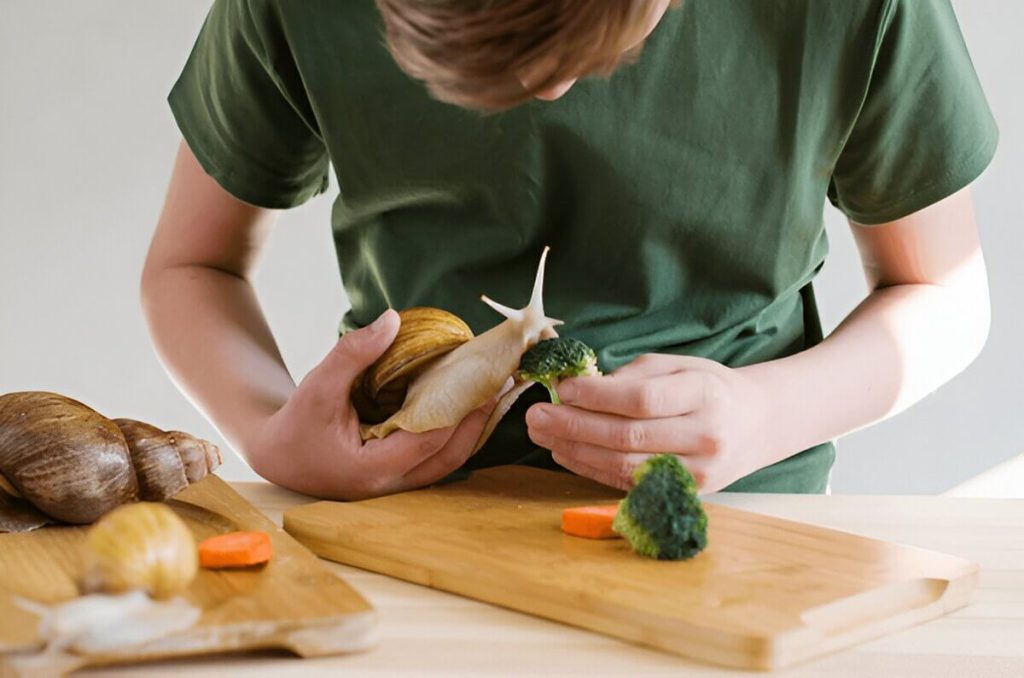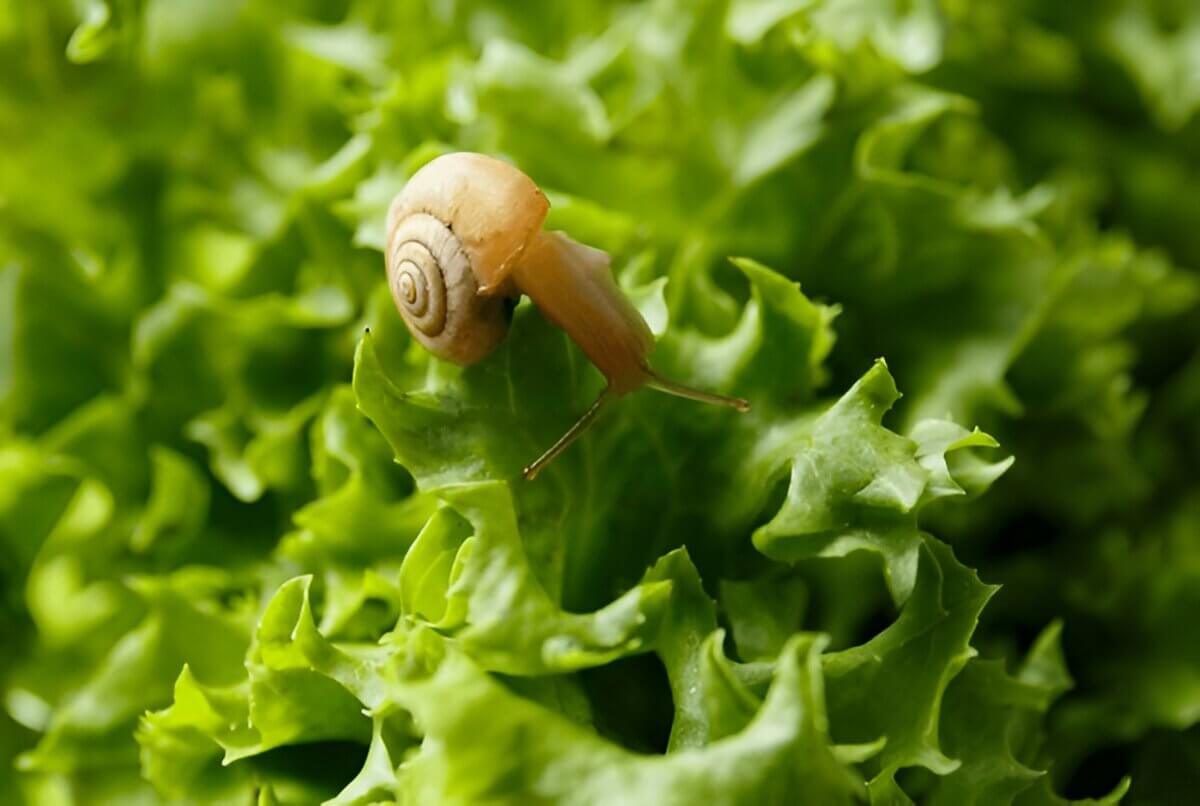Snails, those fascinating creatures that glide silently across our gardens and forests, have a surprisingly diverse diet that reflects their adaptability and ecological niche. Understanding the dietary habits of snails is crucial for both hobbyists who keep them as pets and gardeners who wish to manage their presence.
The snail diet primarily consists of plant material, which includes leaves, stems, and flowers. However, their food preferences can vary significantly depending on the species and habitat. Some snails are known to enjoy decaying organic matter, making them essential contributors to the ecosystem’s nutrient cycle by breaking down decomposing vegetation.
In addition to plant matter, certain snail species have been observed consuming fungi and algae. This dietary flexibility allows them to thrive in a variety of environments from lush gardens to arid landscapes. For pet owners or those interested in cultivating snails for culinary purposes, it’s important to provide a balanced diet that mimics their natural food sources as closely as possible.
Understanding what snails eat not only helps in maintaining healthy snail populations but also aids in managing their impact on agriculture and horticulture. By learning about snail food preferences, we can better appreciate these mollusks’ role within our ecosystems while effectively coexisting with them in shared spaces.
Natural Diet of Wild Snails in Their Habitat
Understanding the natural diet of wild snails in their habitat is essential for appreciating their role in the ecosystem. Snails, whether aquatic or terrestrial, have specific dietary preferences that are adapted to their environment.
Terrestrial snails primarily feed on a variety of plants, making them important participants in the decomposition process. Their diet typically includes leaves, stems, and decaying plant matter. This natural snail diet plays a crucial role in recycling nutrients back into the soil and maintaining ecological balance.
In contrast, aquatic snails have a slightly different approach to feeding. These snails are often found grazing on algae and other organic materials found on submerged surfaces. The presence of aquatic snails helps control algae growth in ponds and streams, contributing to clearer water and healthier aquatic ecosystems.
Both types of snails exhibit fascinating adaptability when it comes to finding food sources within their respective habitats. By consuming plant material whether it’s, terrestrial or aquatic snails play an integral part in sustaining the environments they inhabit, highlighting the importance of understanding wild snail food preferences for conservation efforts.
The Varied Diets of Pet Snails

When it comes to pet snail care, understanding the dietary needs of your shelled friend is essential for their health and longevity. Feeding pet snails requires a bit of knowledge about their natural diet and nutritional requirements. In the wild, snails are known to consume a variety of plant-based foods, which you can easily replicate at home.
The best food for pet snails includes fresh vegetables like lettuce, spinach, and cucumbers. These leafy greens provide essential vitamins and minerals that contribute to snail nutrition at home. Additionally, incorporating fruits such as apples or pears can offer a sweet treat while also delivering necessary nutrients.
It’s important to remember that calcium is crucial for maintaining the strength of your snail’s shell. You can provide this by offering cuttlebone or crushed eggshells in their habitat. Regularly monitoring your pet snail’s diet ensures they receive balanced nutrition and helps prevent potential health issues.
By paying attention to these dietary guidelines, you can ensure that your pet snails thrive in their home environment while enjoying a varied and nutritious diet.
Can Snails Eat Fruits and Vegetables? Exploring Safe and Unsafe Options
When it comes to feeding your pet snails, it’s important to know which fruits and vegetables are safe for them and which ones should be avoided. Snails are herbivores, meaning they thrive on a diet of plant material. However, not all fruits and veggies are suitable for their consumption.
Safe foods for snails include leafy greens like lettuce, spinach, and kale. These provide essential nutrients without posing any risk to their health. Other good options include cucumbers, zucchini, and carrots—all of which can be sliced thinly for easy consumption.
Fruits can also be part of a snail’s diet but should be offered in moderation due to their sugar content. Safe fruit options include apples (with seeds removed), melons, and strawberries. Always ensure the fruits are ripe but not overripe or fermented.
On the other hand, there are certain foods you should avoid giving to your snails due to potential health risks. Citrus fruits like oranges or lemons can be harmful because of their acidic nature. Additionally, salty or processed foods should never be given as they can severely affect a snail’s health.
By carefully selecting the right fruits and veggies for snails and avoiding those that could harm them, you can ensure your shelled companions remain healthy and happy in their environment.
The Role of Calcium in a Snail’s Diet
Calcium plays a pivotal role in the diet of snails, serving as a fundamental building block for healthy shell growth. A snail’s shell is primarily composed of calcium carbonate, and without adequate calcium intake, snails can experience weakened or deformed shells, which can significantly affect their survival.
Understanding the importance of calcium for snails involves recognizing how this mineral contributes to overall health and structural integrity. Calcium not only aids in forming robust shells but also supports other physiological functions essential for a snail’s well-being.
To ensure that snails receive sufficient calcium, it is crucial to provide them with appropriate sources. Common calcium sources for snails include cuttlebone, eggshells, and commercially available calcium supplements. These should be readily accessible in their habitat to allow continuous consumption as needed.
Incorporating these calcium-rich options into a snail’s environment helps maintain optimal health and encourages the development of strong, resilient shells. By prioritizing the availability of these resources, caregivers can play an instrumental role in promoting healthy shell growth and supporting the overall vitality of their shelled companions.
Troubleshooting Common Feeding Problems with Snails
Snails are fascinating creatures that require specific care, especially when it comes to their diet. If you’re encountering snail feeding issues, it’s important to understand the potential causes and solutions. One common question among snail enthusiasts is, “Why won’t my snail eat?” Addressing this concern involves recognizing diet-related problems in snails and making necessary adjustments.
Firstly, ensure that your snail’s environment is conducive to feeding. Snails thrive in humid conditions with access to fresh water and a balanced diet rich in calcium, which is essential for shell health. If your snail isn’t eating, check the humidity levels and temperature of their habitat as these can directly affect their appetite.
Another potential issue could be the type of food offered. Snails may refuse food if it’s not suitable or appealing. They typically enjoy a variety of leafy greens such as lettuce and kale, alongside fruits like apples and cucumbers. Avoid offering foods high in salt or processed items as these can be harmful.
It’s also crucial to recognize any signs of illness or stress that might contribute to feeding problems. A sluggish or retracted snail might indicate health issues requiring veterinary attention.
By paying close attention to these factors, you can effectively troubleshoot common feeding problems with snails and ensure they maintain a healthy diet for optimal well-being.
Maintaining a Balanced Diet for Happy and Healthy Snails
In conclusion, maintaining a balanced diet is crucial for the health and happiness of your pet snails. These gentle creatures require a mix of nutrients to thrive, including calcium for their shells, proteins for growth, and a variety of fruits and vegetables to ensure they receive essential vitamins. Fresh greens such as lettuce or spinach can serve as daily staples, while occasional treats like cucumbers or strawberries add diversity to their diet.
It’s important to avoid feeding your snails foods that are high in salt or sugar, as these can be harmful. Additionally, providing a source of calcium is vital; crushed eggshells or cuttlebone can be excellent supplements. By carefully selecting and rotating the foods you offer, you can help prevent dietary deficiencies and promote overall well-being.
Remember that each species may have specific dietary needs, so it’s beneficial to research the particular requirements of your snail species. By ensuring that your snails receive a well-rounded diet tailored to their needs, you contribute significantly to their longevity and quality of life.
